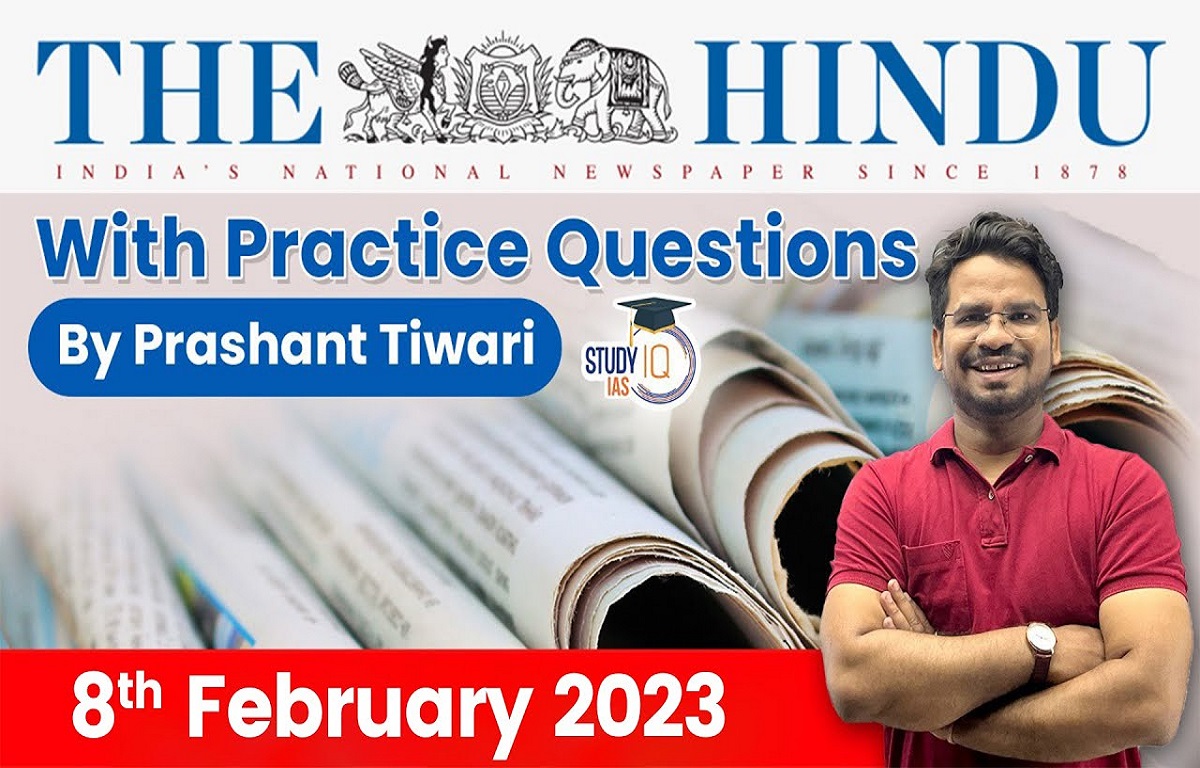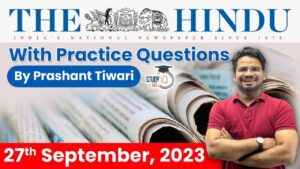The Hindu Newspaper Analysis for UPSC

The Hindu Newspaper Analysis 7 February 2023
- The Delhi High Court on Tuesday ruled that conducting virginity test on a woman accused is “sexist and is in violation of human right to dignity”.
- Justice Swarana Kanta Sharma, in a significant judgment, said, “The virginity test conducted on a woman detainee, accused under investigation, or in custody, whether judicial or police, is declared unconstitutional and in violation of Article 21 of the Constitution”.
- Advocate Romy Chacko, representing Sister Sephy, contended that she was “forcefully subjected to undergo virginity test” by the Central Bureau of Investigation on November 25, 2008, against her consent. Mr. Chacko said the virginity test was conducted by the investigating agency under the pretext of an investigation to substantiate their case.
- “Most shockingly, in the present case the virginity test was used to determine the truth of the accusation of murder against the petitioner [Sister Sephy],” the High Court remarked.
The Hindu Editorial Today

- The Budget for 2023-24 has attempted to address the aspirations of different segments of society. It is a good effort in a difficult situation. But how far do the Budget provisions go to meet the two fundamental goals of growth and stability?
- Growth is affected by the size of government expenditure and its revenue and capital components.
- Increase in the Centre’s capital expenditure is budgeted at 37% while that in revenue expenditure is only 1.2%. According to estimates by the Reserve Bank of India (2019, 2020), the multiplier associated with central government capital expenditure is 2.45, while that for revenue expenditure is 0.45.
- According to the Fiscal Responsibility and Budget Management (FRBM) Act, as amended in 2018, the Centre is mandated to take appropriate steps to limit its fiscal deficit to 3% of GDP by March 31, 2021 although this is an operational target.
- The mandated target pertains to the Centre’s debt-GDP ratio which is to be brought down to 40%. If there is a deviation from the fiscal deficit-GDP ratio of 3%, the Centre is required to state the reasons.
- In the medium-term fiscal policy cum Fiscal Policy Strategy Statement (MTFP), the Centre has attributed the deviation of the budgeted 5.9% fiscal deficit-GDP ratio to external economic conditions.
- Furthermore, the Centre has also not indicated the year by which it envisages reaching a fiscal deficit level of 3% of GDP. Instead, it has indicated that a level of 4.5% of GDP would be reached by 2025-26, calling for a steeper adjustment of 0.7% points each in the next two years.
- However, even by this time, the mandated debt-GDP ratio of 40% would not be reached. The Centre’s debt-GDP level net of liabilities on account of investment in special securities of states under the National Social Security Fund (NSSF), is budgeted to increase from 55.7% in 2022-23 (RE) to 56.1% in 2023-24 (BE). This increase is expected as the primary deficit to GDP ratio is indicated at 2.3% in 2023-24.
- We know the dilemma faced by the government. Any further reduction in the fiscal deficit will cut expenditures which may not be appreciated. We need, however, a stronger fiscal consolidation road map over the medium term.

- It may be argued that the government has been fair in this year’s Budget by providing free foodgrains to 80 crore poor people; developing 500 backward blocks; broadening access to housing, clean water, and toilets; providing employment through the rural employment guarantee scheme; and providing opportunities for skill development.
- But these can only have partial gains; they do not necessarily address the issue of widening inequality. Besides, for sustainable, long-term growth of the country, expanding universal access to high quality education, healthcare and nutrition (not just foodgrains but proteins and other supplementary foods that are currently unaffordable) is imperative.
- No country can go far if a significant proportion of its population is illiterate, unhealthy or malnourished. All the countries that are developed today invested well in education, health and nutrition.
- A study showed that 230 million Indians slid into poverty due to COVID-19. The ASER report shows the abysmal state of education — many Class 5 students are unable to read a Class 2 textbook.
- NFHS-5 data show that among children aged below five years, 35.5% were stunted and 32.1% were underweight. Yet, the allocations for education and nutrition are stagnant.
- The budget for midday meals reduced by 9%, not counting for inflation, even as data show a shift in enrolment from private to public schools with private schooling becoming unaffordable.
- Disease burden is rising with non-communicable diseases, mental health and geriatric care adding to the load of communicable diseases.
- India lacks adequate human resources, infrastructure and access to affordable diagnosis and treatment.
- Equity and justice are values that must guide a polity to build a nation. Measuring policy and money allocation only in terms of political expediency is short-term and unsustainable.
- When such structures collapse, as they will, it is the poor and marginalised who will suffer disproportionately.
- But then disease is an equaliser — many rich people also died during COVID-19 for want of access to a hospital bed or oxygen. The price we paid then, and the lessons learned, need to be remembered.
- Neglecting the health sector and denying it of critical investments has consequences.

- India has witnessed a more than four-fold increase in the number of electors since 1962 to over 94.5 crore this year, but almost one-third of them stayed away from exercising their franchise in the last Lok Sabha polls.
- This has prompted the Election Commission of India (ECI) to walk the extra mile to bring them to the polling booths.
- Amid talks of taking the voter turnout to 75%, the ECI has recognised that people from urban areas, young voters, and migrants formed a big part of the 30 crore missing voters in the last Lok Sabha election.
- The ECI has a big task on hand given that India’s number of registered voters is almost four times that of the U.S., the second country on the list. India’s voter base exceeds the combined numbers of the U.S., Indonesia, Brazil, Russia, Pakistan and Japan.
- India, with a voter turnout of 67.1% in the last Lok Sabha elections, ranked 74th among the 162 countries whose data were compared (Chart 4). India’s vote share lagged behind the turnouts recorded in Bangladesh (80%), Brazil (79.2%) and Sri Lanka (75%), but surpassed the turnouts in Russia (51%), Pakistan (50%) and Nepal (61%).

- Despite the impressive growth of wind and solar power, renewable energy by itself will not be sufficient, particularly to transition industries that are entirely dependent on fossil fuel, according to Sultan Al Jaber, the president-designate of the next UN summit on climate change.
- This year’s Conference of Parties (COP-28) of the UN Framework Convention on Climate Change will be hosted by the UAE, which holds one of the world’s largest oil and gas reserves.
- “Without a breakthrough in battery storage, we must invest heavily in carbon capture, nuclear power, and the hydrogen value chain. But spending on these fundamental enablers of decarbonisation is less than 5% of what is spent on renewables. This must change. And when it comes to change, this also applies to the oil and gas industry. The world still needs hydrocarbons and will need them to bridge from the current energy system to the new one. We cannot unplug the current energy system before we have built the new one,” Mr. Al Jaber said.

- The three major forms of treatment for any cancer are surgery (removing the cancer), radiotherapy (delivering ionising radiation to the tumour), and systemic therapy (administering medicines that act on the tumour). Surgery and radiotherapy have been refined significantly over time whereas advances in systemic therapy have been unparalleled.
- Systemic therapy’s earliest form was chemotherapy; when administered, it preferentially acts on cancer cells because of the latter’s rapid, unregulated growth and poor healing mechanisms. Chemotherapeutic drugs have modest response rates and significant side-effects as they affect numerous cell types in the body.
- The next stage in its evolution was targeted agents, also known as immunotherapy. Here the drugs bind to specific targets on the cancer or on the immune cells that help the tumour grow or spread. This method often has fewer side-effects as the impact on non-tumour cells is limited. However, it is effective only against tumours that express these targets.
- Unlike chemotherapy or immunotherapy, which require mass-produced injectable or oral medication, CAR T-cell therapies use a patient’s own cells. They are modified in the laboratory to activate T-cells, a component of immune cells, to attack tumours.
- These modified cells are then infused back into the patient’s bloodstream after conditioning them to multiply more effectively.
- The cells are even more specific than targeted agents and directly activate the patient’s immune system against cancer, making the treatment more clinically effective. This is why they’re called ‘living drugs’.
- As of today, CAR T-cell therapy has been approved for leukaemias (cancers arising from the cells that produce white blood cells) and lymphomas (arising from the lymphatic system).
- Chimeric Antigen Receptor (CAR)-T
- T cell, also called T lymphocyte, type of leukocyte (white blood cell) that is an essential part of the immune system.



 The Hindu Newspaper Analysis 6 October 2...
The Hindu Newspaper Analysis 6 October 2...
 The Hindu Newspaper Analysis 30 Septembe...
The Hindu Newspaper Analysis 30 Septembe...
 The Hindu Newspaper Analysis 27 Septembe...
The Hindu Newspaper Analysis 27 Septembe...





















